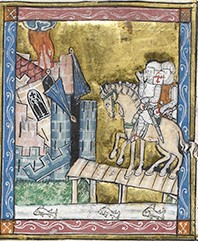CLICK TO REGISTER
MEDIEVAL STUDIES 301 European Literature from the 5th to the 14th Century: Journeys to the East: Tales of Travel and Conquest in Medieval French Literature (3 credits)
(cross-listed with RMST 321)

Term 2: MW 12:30-2:00 pm
Prof. Patrick Moran, Department of French, Hispanic and Italian Studies
Office: (604) 822-3548
patrick.moran@ubc.ca
The European Middle Ages did not occur in a bubble: medieval Europe was part of an interconnected social, political, economic and cultural continuum that spanned much of Eurasia and Africa, and included a myriad religions, languages and societies. This course aims to explore this global medieval world through the lens of French literature: how it represented non-feudal and non-majority-Christian cultures, what sort of contacts it focused on (peaceful or aggressive), and the ways in which it indirectly depicted itself through describing (or fantasizing) the “Other”.
The course will therefore focus on medieval representations of the world and of societies and cultures beyond Western Europe, as well as early instances of Orientalism and Othering, through fictional and factual accounts. Texts will include The Song of Roland and its confrontational depiction of the Muslim world; Villehardouin’s chronicle of the Fourth Crusade (in Constantinople) and Joinville’s chronicle of the Seventh (in Egypt); and two key travel narratives: Marco Polo’s real-life record of his journey to the court of Kublai Khan and back, and John Mandeville’s more dubious Book of Wonders. Study of these Western texts will be interspersed with guest lectures from specialists of the Muslim World, the Byzantine Empire, and Medieval China, who will help us understand the obverse perspective, showcasing how the medieval continuum goes both ways.
Required readings:
- The Song of Roland and Other Poems of Charlemagne, Oxford World’s Classics, 2016
- Joinville and Villehardouin, Chronicles of the Crusades, Penguin Classics, 2009
- Marco Polo, The Travels, Penguin Classics, 2016
- John Mandeville, The Book of Marvels and Travels, Oxford World’s Classics, 2012